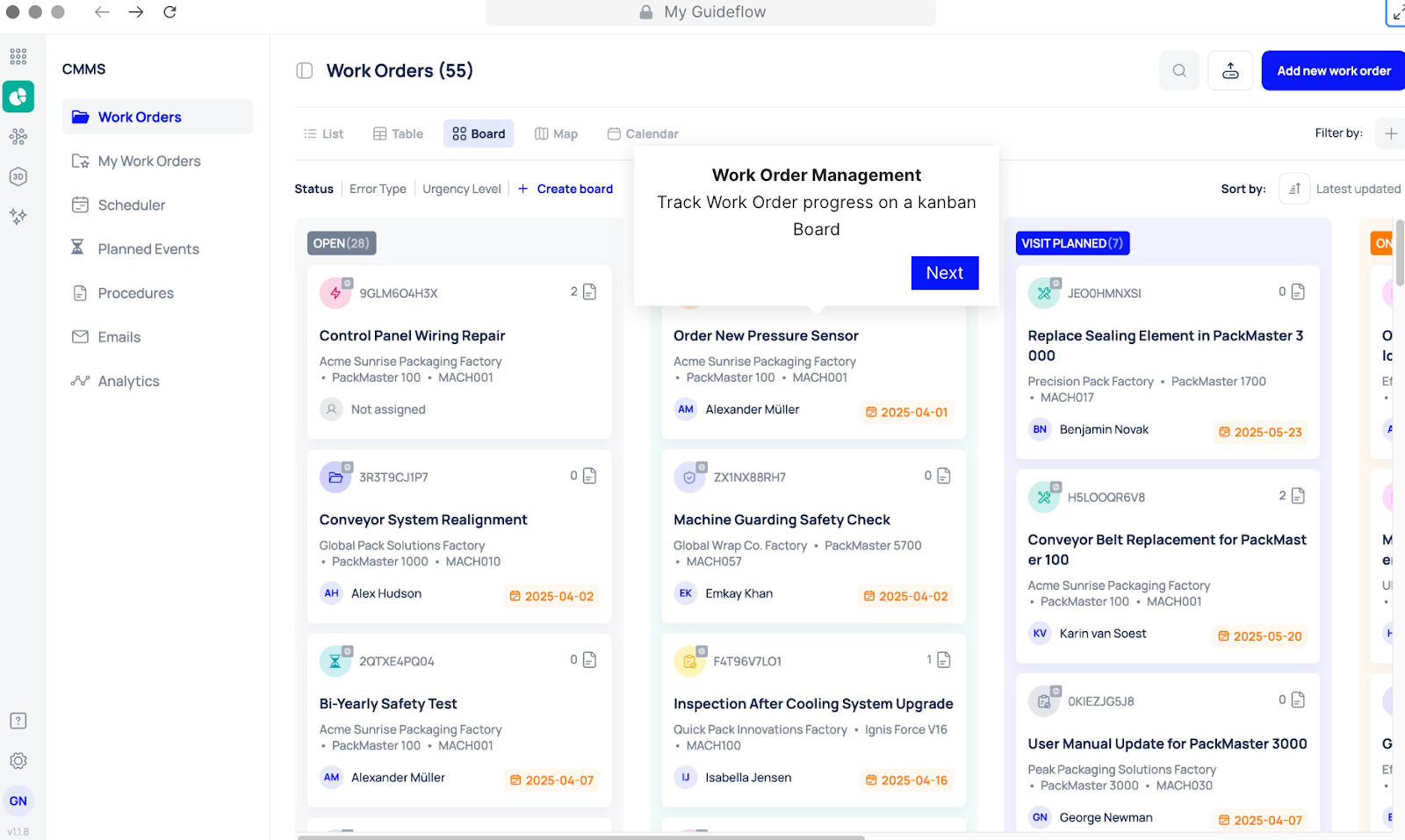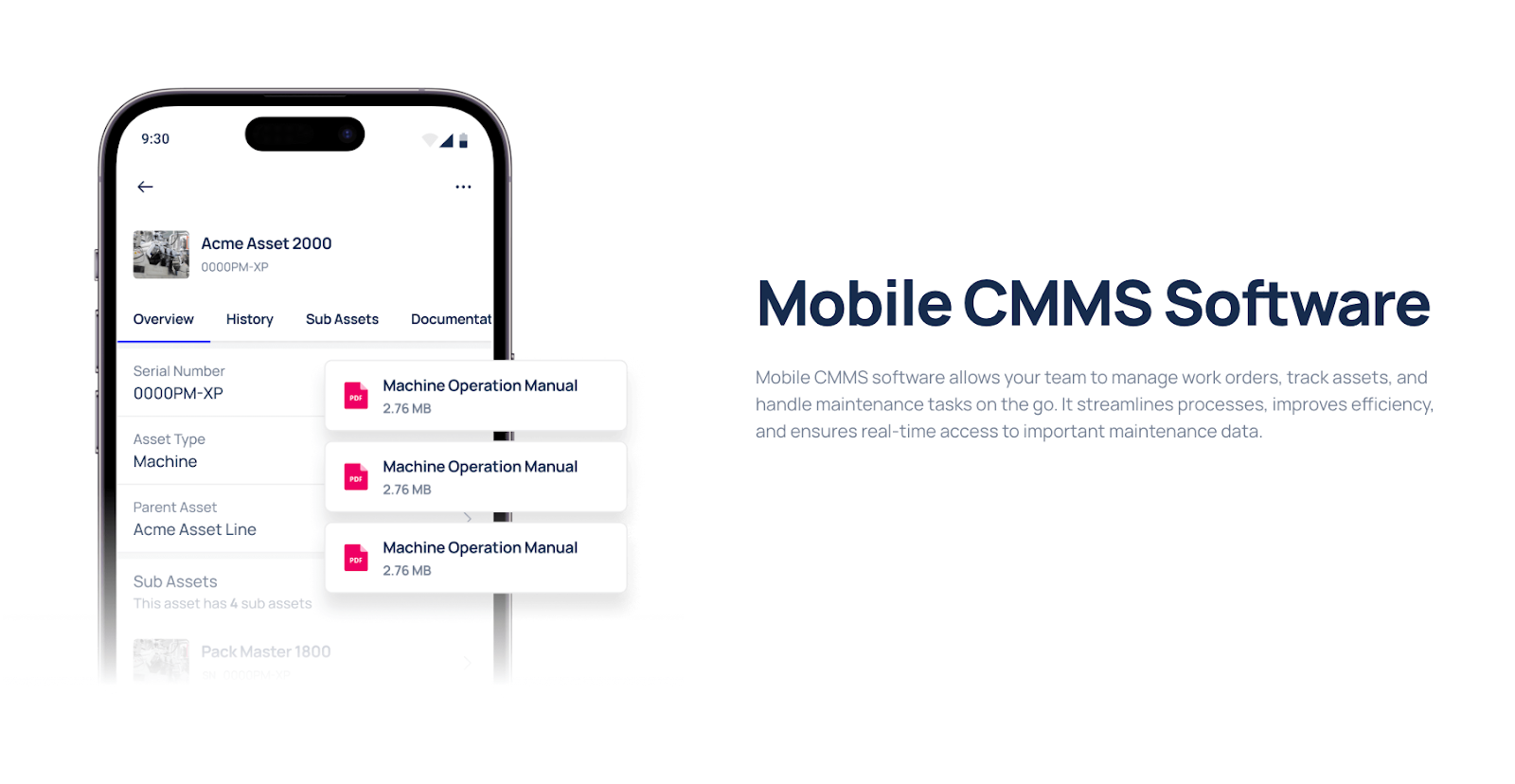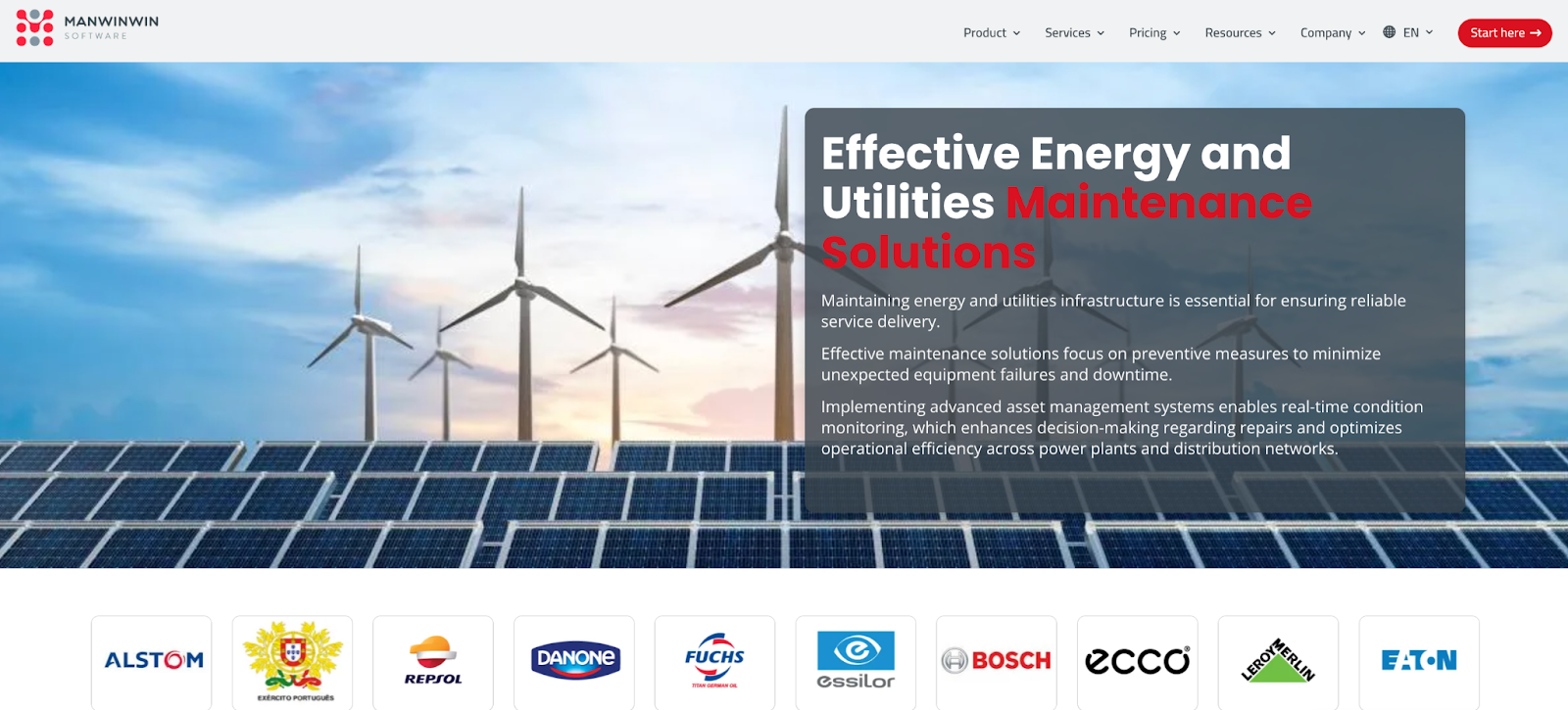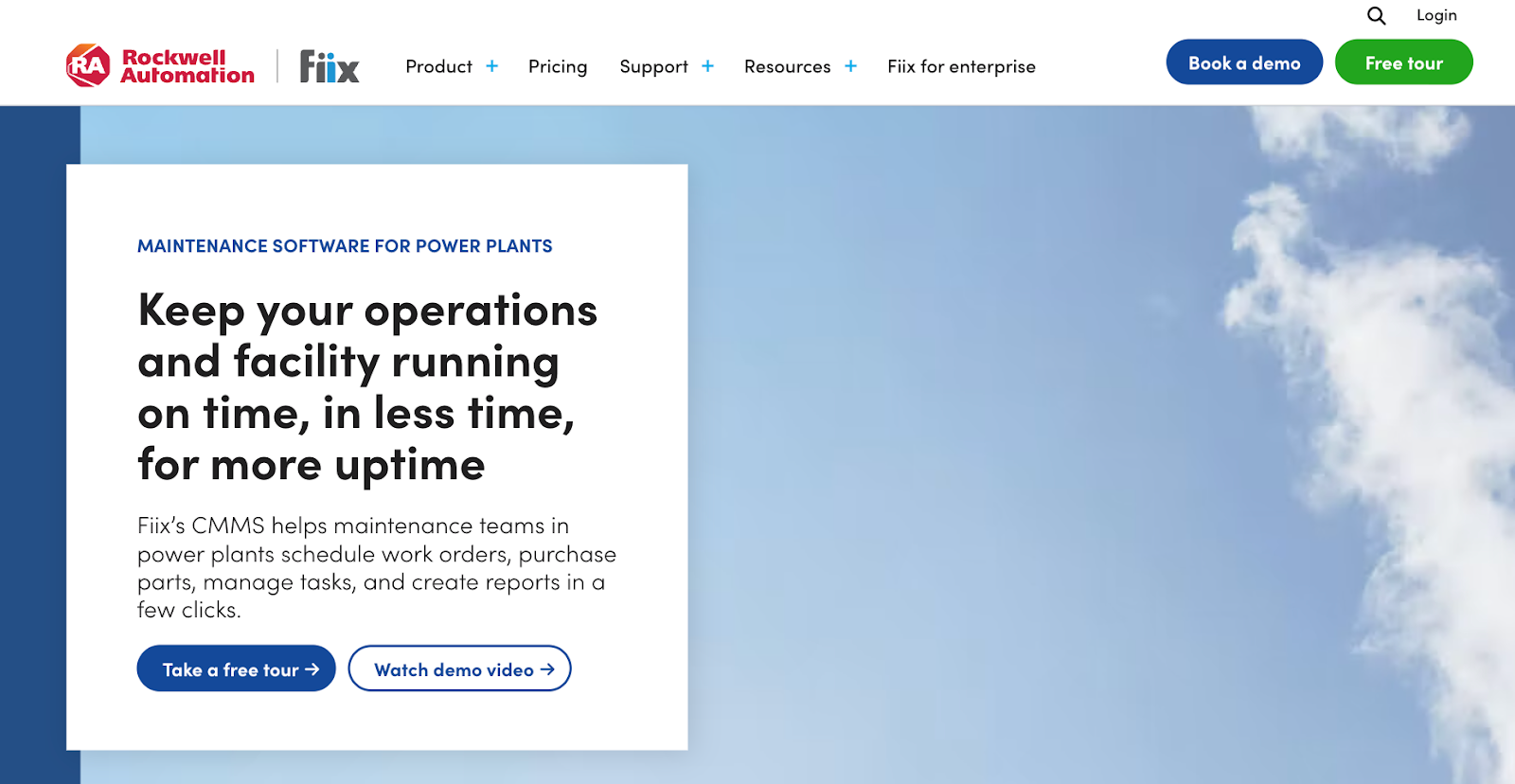Most power plant maintenance teams still rely on spreadsheets or outdated CMMS tools that can't keep up.
Power plants operate under strict reliability standards. Every task must be logged, verified, and audit-ready. Manual tracking makes that nearly impossible.
We've reviewed the best maintenance software for power plants in 2026. These tools help you prevent failures, stay compliant, and keep operations running without interruption.
What Is Power Plant Maintenance Software?
Power plant maintenance software is a computerized maintenance management system (CMMS) designed to help facilities manage assets, maintenance work, and compliance.
It replaces paper logs and spreadsheets with a centralised system that tracks equipment data, schedules maintenance, and records inspection results automatically. Every turbine, generator, and transformer has a complete service history that can be reviewed at any time.
In power generation, traceability is critical. Power plants must show exactly:
- When plant maintenance was performed
- What procedures were followed
- Who verified the work.
A reliable CMMS makes this possible by creating time-stamped records linked to each asset.
Beyond recordkeeping, power plant maintenance software helps teams prevent breakdowns before they happen. It schedules inspections, sends automatic alerts, and stores all documentation needed for audits.
Trends and Challenges in Power Plants
The power and energy sector faces unique maintenance challenges. Power plants must run continuously while meeting strict safety and environmental standards.
Below are the key factors shaping maintenance in 2026:
Producing Safe and Reliable Energy
Power plants must stay online while producing energy that’s both efficient and safe. Facilities such as nuclear, coal, hydro, and gas plants operate under constant public and environmental scrutiny. Maintenance teams must prevent downtime without compromising worker safety or compliance.
Aging Equipment and Continuous Inspections
Power generation assets must operate continuously, leaving little room for downtime. Turbines, generators, and cooling systems require constant inspection to detect wear, vibration, and overheating early.
Manual inspection processes are slow and increase the risk of missing faults. Without automated monitoring and timely data, teams may fail to identify critical issues before they lead to outages or equipment damage.
Wind and Renewable Energy Maintenance
Wind farms and renewable facilities face different challenges. Equipment is distributed across large areas, exposed to harsh conditions, and requires frequent remote monitoring. Technicians need to plan preventive maintenance at precise intervals to avoid costly equipment failures and loss of output.
Stricter Safety and Regulatory Compliance
Power and energy operations must meet strict standards from regulatory bodies such as:
- Occupational Safety and Health Administration (OSHA)
- Environmental Protection Agency (EPA)
- Federal Energy Regulatory Commission (FERC)
Missing updates or failing to document inspections can lead to costly penalties, forced shutdowns, or compliance gaps that put worker safety and plant reliability at risk.
Data Integration and Real-Time Visibility
Most plants use multiple systems, such as Supervisory Control and Data Acquisition (SCADA), Enterprise Resource Planning (ERP), and inventory management platforms. When these systems don’t connect, important data is lost.
Skilled Labor Shortages and Knowledge Transfer
The power sector is losing experienced maintenance staff as many retire or move on. These technicians hold decades of knowledge about turbines, boilers, and control systems that are difficult to replace.
New workers often lack hands-on experience with complex or aging equipment, making it harder to perform preventive maintenance, diagnose issues, and maintain consistent safety standards.
Pressure to Improve Efficiency and Sustainability
Energy producers face growing pressure to reduce waste and emissions while extending asset life. Maintenance data helps track energy efficiency, predict failures, and plan interventions that support sustainability goals.
Best Maintenance Software for Power Plants in 2026
Below are the leading maintenance software solutions for power plants in 2026:
Makula

Makula is a computerized maintenance management system (CMMS) designed for power and energy operators. It’s built for complex energy infrastructure and connects turbines, transformers, and generators across multiple sites in a single dashboard.
It brings together work orders, asset data, and compliance records to help teams reduce downtime and meet regulatory standards.
Unlike traditional CMMS tools that rely on manual entries and siloed data, Makula provides real-time visibility into every maintenance task, asset condition, and inspection record. This allows operators to keep plants running safely and stay audit-ready year-round.
Here are Makula’s key features that help power plants improve equipment reliability and traceability:
Centralised Asset Hub for Power Generation Networks

Power generation companies operate across multiple plants, substations, and renewable sites, each with its own maintenance data and asset registers. Without a connected view, it’s hard to track:
- Which units are due for servicing
- Which spare parts are available
- Where the next failure risk lies
Makula’s Asset Hub connects every generator, switchgear, and control system into a unified maintenance record, helping maintenance and engineering teams plan.
Here’s how the Asset Hub supports power generation operations:
- Multi-site coordination: Monitor equipment health and service schedules across all plants and renewable sites.
- Bulk import and asset tagging: Upload existing records and tag assets by voltage level, system type, or site.
- Linked documentation: Store and access calibration certificates, inspection logs, and compliance reports.
- Searchable records: Retrieve service and inspection data instantly during internal reviews or audits.
Work Order Management for Planned and Recurring Maintenance

Power plants run on tight maintenance schedules. When work orders are delayed, duplicated, or sent to the wrong team, it leads to unplanned downtime and missed performance targets.
Makula’s Work Order Management helps operations teams plan, assign, and verify every maintenance activity. Each job is automatically routed to the right technician or department based on location, role, and priority.
When you open a work order, the Overview tab shows all critical details needed for tracking and traceability:
- Work Order ID
- Created Date
- Reporter
- Assignee
- Scheduled Date & Time
The system supports recurring maintenance and auto-generated tasks to keep key assets serviced on time. For example, a generator inspection due every 250 hours can be auto-generated and assigned without manual input.
Technician Mobile App with Offline Capability

Power plant technicians work in environments with limited or no connectivity, like turbine halls, remote substations, or underground service tunnels.
Makula’s Technician Mobile App gives field teams full access to maintenance data anywhere they work. The app allows technicians to view tasks, log updates, and close work orders directly from their devices. All activity syncs automatically once the connection is restored.
Here’s how it supports field operations:
- Continue working without Wi-Fi or network coverage
- Data syncs automatically once the connection returns
- Technicians can view asset details, procedures, and checklists on-site
- Photos, notes, and meter readings can be added directly in the app
By keeping maintenance workflows mobile and uninterrupted, Makula helps field teams stay productive and accurate, even in remote or high-restriction power environments.
Parts and Inventory Management with Auto Reordering

Every minute a power plant waits for spare parts adds risk. A single missing valve, fuse, or filter can delay generation, increase costs, and affect uptime.
Makula’s Parts and Inventory Management gives maintenance teams complete visibility and control over spare parts, tools, and consumables. It tracks stock levels in real time, sets smart reorder points, and automates purchases before shortages occur.
Here’s how it supports power plant operations:
- Monitor inventory across multiple sites, warehouses, and substations
- Get low-stock notifications, such as “You have less than 10 stocks available”
- Restock automatically based on consumption trends and reorder thresholds
- Assign parts to planned maintenance tasks to prevent delays
- Link each part to specific work orders for accurate usage records
- Transfer or share spare parts across facilities to optimise stock levels
By maintaining accurate inventory and automating reorders, Makula helps power producers reduce downtime and avoid costly emergency purchases.
Integrations With ERP, SCADA, and Condition Monitoring Systems

Power and energy plants depend on multiple systems for operations like ERP, SCADA, and IoT tools to monitor generation efficiency, pressure, and performance.
Makula integrates these systems into one central platform. Its API-based architecture supports both on-premise and cloud setups, allowing communication across multiple departments.
Here’s how Makula supports connected maintenance:
- ERP integrations: Sync work orders, spare part usage, vendor data, and cost centres with ERP systems such as SAP, Oracle, or Microsoft Dynamics.
- SCADA and IoT connections: Pull live data from turbines, pumps, and transformers to trigger maintenance tasks automatically when performance limits are reached.
- Customer and asset data sync: Import serial numbers, warranty details, and specifications directly from ERP or PLM systems to keep asset records current.
- Document and CAD data transfer: Centralise manuals, compliance documents, and 3D models from SharePoint or PDM systems for easy technician access.
- Low-cost integration options: Smaller facilities can use CSV or Excel importers to update thousands of records instantly without custom development.
Analytics and Custom Reporting for Smarter Maintenance Decisions

Power plants depend on real-time data to make critical maintenance and safety decisions. Without accurate visibility, small issues can grow into costly failures, and compliance reports become harder to prepare.
Makula’s analytics and custom reporting give a unified view of all maintenance activities, asset conditions, and technician performance across sites. Custom dashboards help track different KPIs like:
- Mean Time to Repair
- Mean Time Between Failures
- Asset Availability Rate
- Maintenance Cost per Megawatt
- Work Order Completion Rate
Users can also view open, in-progress, and completed work orders alongside downtime and maintenance performance across all sites.
Makula Pros & Cons
Pros
- Strong audit and compliance tracking tools
- Mobile app with full offline functionality
- Centralised Asset Hub with real-time visibility
- Automated preventive maintenance scheduling
- Broad ERP, SCADA, and IoT integration support
- Modular design that scales with multi-site operations
- Intuitive interface with minimal setup time
Cons
- Some advanced features require setup and onboarding support
Makula Reviews
Review #1: “I have all my products well organized, and all the relevant information is available in one place. I no longer need Excel spreadsheets, SharePoint, or other scattered tools. Everything I need for customer service is consolidated into a single solution.”
Review #2: “The overview of all the latest offers, spare part orders, invoices, and service reports helps the customer enormously. The software has really developed very well, and Makula is doing a great job. The service is great, if I need something, there is always an answer from Karina very quickly.”
Makula Pricing
Makula’s CMMS starts at €55 per user per month. Pricing may vary based on team size, selected modules, and integration requirements.
UpKeep

UpKeep stands out for its ease of use and mobile-first design. It’s built for teams that need to manage maintenance tasks quickly from anywhere on the plant floor.
The platform emphasises flexibility, allowing maintenance and operations staff to create, track and close work orders on the go. With inspection workflows and asset tracking, UpKeep helps power-plant teams stay productive and organised without heavy training or complex setup.
Learn more: Upkeep Alternatives
UpKeep Key Features
- Mobile work order and task updates
- Preventive maintenance scheduling
- Inspection and checklist templates
- Inventory and parts management
- QR/barcode scanning for assets
- Reporting and analytics dashboards
- Integration with ERP and other business systems
UpKeep Pricing
UpKeep offers Essential, Premium, Professional and Enterprise plans. Pricing starts at $20 per user per month, with higher tiers available for additional features.
ManWinWin

ManWinWin differentiates itself with a strong focus on regulatory compliance, multilingual support and asset-heavy environments. It’s built for operations that must follow strict standards and track maintenance outcomes with audit-friendly tools.
The software allows teams to link asset maintenance, cleaning schedules and verification logs in one place. Its flexible license models make it a good fit across sites and geographies.
ManWinWin Key Features
- Sanitation and audit-friendly scheduling
- QR/NFC tag scanning in the field
- Digital signatures and verification logging
- Offline mobile maintenance capability
- Predictive alerts and AI insights
- Asset data, manuals and document storage
- Centralised inventory and parts management
ManWinWin Pricing
ManWinWin offers Express (free up to 100 assets), Start, Professional, and Business plans. Professional plan starts at €39 per user/month with unlimited assets.
Fiix

Fiix is built for asset-intensive plants with complex maintenance networks. It connects maintenance operations with data, providing a centralised view across sites and advanced analytics to identify risk early.
Its AI module, “Fiix Foresight,” gives intelligence on asset health, failure trends, and maintenance prioritisation, making it ideal for large power-generation or utility operations.
Fiix Key Features
- Audit trail with time-stamped maintenance records
- Preventive maintenance and recurring scheduling
- Multi-site dashboards and centralised reporting
- Mobile app with offline access
- Inventory and parts tracking
- AI-powered predictive maintenance insights
- Digital documentation and e-signatures
Fiix Pricing
Free and Basic plans are available. Paid plans start at $45 per user/month (Basic).
Limble CMMS

Limble CMMS is designed for businesses that want core CMMS functionality without extensive setup. Its clean interface, drag-and-drop scheduling, audit-ready documentation, and offline mobile access make it well-suited for plants with multiple shifts and remote sites.
Learn more: Upkeep vs Limble vs Makula
Limble CMMS Key Features
- Automated preventive maintenance scheduling
- Offline mobile work-order updates
- Asset tracking with QR/barcode scanning
- Integrated parts inventory management
- Audit-ready documentation and reports
- Vendor and purchase-order workflows
- Real-time dashboards and analytics
Limble CMMS Pricing
Pricing starts at $28 per user/month.
FTMaintenance

FTMaintenance offers mature functionality aimed at larger or specialised maintenance operations, including MRO inventory, work-order automation and long asset-life management across heavy-duty equipment.
FTMaintenance Key Features
- Asset management and equipment hierarchies
- Preventive and corrective maintenance workflows
- MRO inventory and spare-parts tracking
- Work-order automation and mobile access
- Analytics and downtime reporting
- Custom module and deployment options
- Multi-site role-based access
FTMaintenance Pricing
The company offers custom pricing depending on deployment and modules; entry-level starts around $5,000 annually for basic configurations.
EquipMate

EquipMate targets maintenance teams that need to track equipment lifecycle, parts consumption, and work-orders across large asset bases. Its modular design supports both tracking and maintenance workflow automation.
EquipMate Key Features
- Work-order management specifically for large equipment assets
- Preventive maintenance scheduling and repeat tasks
- Asset lifecycle and usage tracking
- Parts and inventory management with alerts
- Mobile app support and desktop access
- Data reports and dashboards for maintenance insights
- Role-based access and approvals
EquipMate Pricing
Standard plan starts at $200/month for ~20 users.
Comparison Table: 7 Best Power Plant Maintenance Software in 2026
How to Choose the Right Power Plant Maintenance Software
When comparing CMMS platforms for the power and energy sector, it’s easy to get caught up in long feature lists.
Here’s how to evaluate them step by step so you can choose the system that fits your facility’s maintenance goals.
Multi-Site Asset Visibility
Many operators manage several plants, substations, or remote wind sites. A strong CMMS should centralise data across all facilities while allowing each site to manage its own maintenance schedules.
Look for platforms with a unified asset register and visual dashboards that let managers monitor performance and uptime in real time.
Makula’s Asset Hub offers multi-site dashboards that provide instant visibility across locations, helping leaders make faster and data-backed maintenance decisions.
Parts and Inventory Management
Downtime happens when critical parts aren’t in stock. Your CMMS should track spare parts across warehouses, send automatic low-stock alerts, and manage transfers between plants. Makula include smart reorder points and instant stock notifications to prevent shortages.
Integration with Existing Systems
Maintenance data should flow smoothly between your CMMS and other operational systems such as Enterprise Resource Planning (ERP), Supervisory Control and Data Acquisition (SCADA), or Internet of Things (IoT) sensors.
Integration capabilities ensure accurate cost tracking, condition-based maintenance, and consistent reporting across departments.
Mobile and Offline Access
Maintenance often takes place in remote or high-voltage zones where connectivity is limited. Choose a platform with a mobile app that lets technicians view and update work orders, safety procedures, and parts lists offline. The app should automatically sync once reconnected to the network.
Makula’s mobile app allows teams to complete inspections, log work, and access manuals even in low-connectivity zones, so that no task is missed in the field.
Analytics and Reporting
Choose a platform that provides clear visibility into key performance indicators (KPIs) like Mean Time to Repair (MTTR), Mean Time Between Failures (MTBF), and asset availability.
These metrics help identify bottlenecks, optimise preventive maintenance, and support data-driven decision-making.
Regulatory and Safety Compliance
Power generation sites operate under strict safety and environmental regulations from official agencies. The right software should maintain digital records of inspections, corrective actions, and certifications so your team is always audit-ready.
Makula’s CMMS automatically logs every inspection, maintenance event, and safety action with time-stamped records, helping plants stay compliant and ready for review.
Scalability and Support
Your maintenance software should grow with your operations, from a single plant to a regional or global network. Before purchasing, confirm that the vendor offers onboarding assistance, user training, and integration support tailored to the energy sector.
Bottom Line: Makula is the Best Power Plant Maintenance Software i
Unplanned outages and non-compliance with safety or environmental standards can lead to massive losses in production, penalties, and grid instability. Every maintenance activity in a power plant must be recorded, verified, and ready for inspection at any time.
Makula gives energy teams a trusted system to manage maintenance, track assets, and ensure full compliance, all while keeping generation reliable and downtime low.
Book a demo to see how Makula can help your facility stay efficient and inspection-ready.



.webp)

